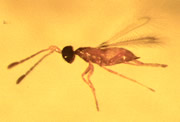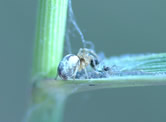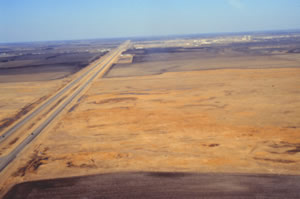Host-Parasitoid Spatial/Landscape Ecology
The Tall Grass Prairie System
Tall-grass prairie is one of the most imperiled and degraded ecosystems in the world. Of the estimated 1.5 million km 2 of grassland that existed prior to the settlement of Europeans in North America, less than 1% remains today. These remaining prairie fragments have been very susceptible to the colonization and establishment of alien grass species.
In North Dakota tall-grass prairies, the native species Spartina pectinata Link (prairie cordgrass) occurs in very discrete patches, ranging from a few stems to over 4 ha (Cronin 2003).
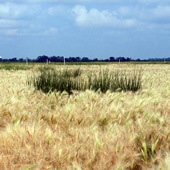
The matrix associated with cordgrass patches consists of 3 basic types: mudflats of mostly bare ground, mixed native grasses, and monocultures of exotic smooth brome, Bromus inermis Leyss (Cronin 2003, Cronin & Haynes 2004, Haynes & Cronin 2003). Brome is a very aggressive weed that has displaced much of the native flora, even invading mudflats. Based on our own surveys, 1/3 of the small to medium-sized cordgrass patches in brome (< 25 m 2) were displaced within a 4-year period of time (Dillemuth & Cronin, unpubl. data). At our study sites in North Dakota, the matrix is composed of approximately 30% mudflat, 40% native non-host grasses, and 30% brome.

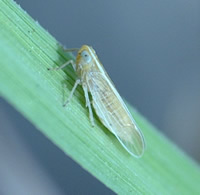
P. crocea is the dominant herbivore of cordgrass and exhibits 2 distinct generations per year in North Dakota, with adult densities peaking in mid-late June and again in early August (Cronin 2003). Adults live 1-2 weeks and lay eggs in cordgrass leaves. The suite of natural enemies that attack P. crocea includes egg and nymphal/adult parasitoids and many arthropod predators, particularly spiders (Cronin et al. 2004). The mymarid egg parasitoid Anagrus columbi Perkins (Cronin 2003) is by far the most dominant parasitoid, killing » 21% of the P. crocea eggs per patch (range: 2.7-64.5%). In our prairie landscapes, A. columbi attacks only P. crocea. The foraging and movement behavior of this egg parasitoid is quite similar to that of the congener A. sophiae, a parasitoid of the salt-marsh planthoppers P. marginata and P. dolus that I have studied extensively in the past (Cronin & Strong 1990a,b, 1993a,b, 1996, 1999, Reeve et al. 1994a,b). Finally, there are ca. 20 species of spiders foraging for prey within our cordgrass patches, but these generalist predators appear to have minimal impact on planthopper mortality (Cronin et al. 2004).
